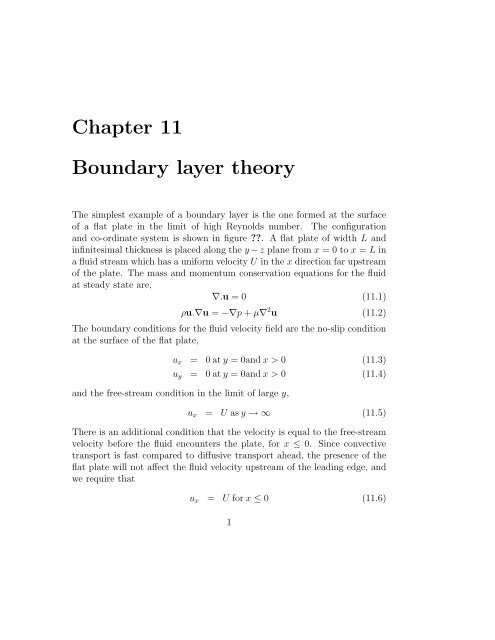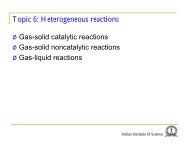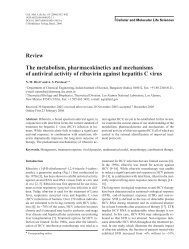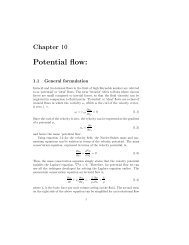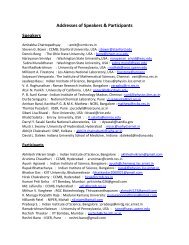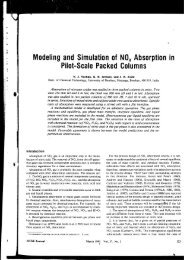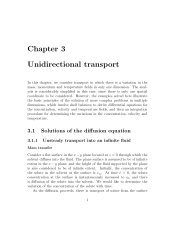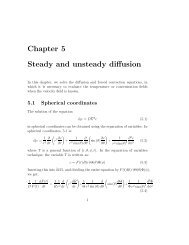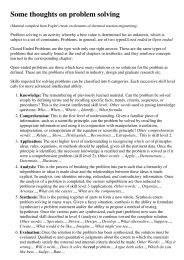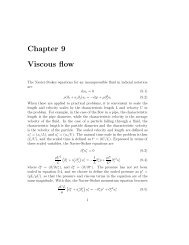Chapter 11 Boundary layer theory
Chapter 11 Boundary layer theory
Chapter 11 Boundary layer theory
You also want an ePaper? Increase the reach of your titles
YUMPU automatically turns print PDFs into web optimized ePapers that Google loves.
<strong>Chapter</strong> <strong>11</strong><br />
<strong>Boundary</strong> <strong>layer</strong> <strong>theory</strong><br />
The simplest example of a boundary <strong>layer</strong> is the one formed at the surface<br />
of a flat plate in the limit of high Reynolds number. The configuration<br />
and co-ordinate system is shown in figure . A flat plate of width L and<br />
infinitesimal thickness is placed along the y −z plane from x = 0 to x = L in<br />
a fluid stream which has a uniform velocity U in the x direction far upstream<br />
of the plate. The mass and momentum conservation equations for the fluid<br />
at steady state are,<br />
∇.u = 0 (<strong>11</strong>.1)<br />
ρu.∇u = −∇p + µ∇ 2 u (<strong>11</strong>.2)<br />
The boundary conditions for the fluid velocity field are the no-slip condition<br />
at the surface of the flat plate,<br />
u x = 0 at y = 0and x > 0 (<strong>11</strong>.3)<br />
u y = 0 at y = 0and x > 0 (<strong>11</strong>.4)<br />
and the free-stream condition in the limit of large y,<br />
u x = U as y → ∞ (<strong>11</strong>.5)<br />
There is an additional condition that the velocity is equal to the free-stream<br />
velocity before the fluid encounters the plate, for x ≤ 0. Since convective<br />
transport is fast compared to diffusive transport ahead, the presence of the<br />
flat plate will not affect the fluid velocity upstream of the leading edge, and<br />
we require that<br />
u x = U for x ≤ 0 (<strong>11</strong>.6)<br />
1
2 CHAPTER <strong>11</strong>. BOUNDARY LAYER THEORY<br />
As we shall see later, though the point x = y = 0 is a mathematical singularity,<br />
this does not complicate the solution procedure for the velocity profile.<br />
The naive method for scaling the mass and momentum equations is to<br />
use scaled co-ordinates x ∗ = (x/L), y ∗ = (y/L) and u ∗ = (u/U), since L<br />
and U are the only length and velocity scales in the problem. The appropriate<br />
scaled pressure in the high Reynolds number limit is p ∗ = (p/ρU 2 ).<br />
Expressed in terms of the scaled velocity and pressure, the mass and momentum<br />
conservation equations are,<br />
∇ ∗ .u ∗ = 0 (<strong>11</strong>.7)<br />
u ∗ .∇ ∗ u ∗ = −∇p ∗ + Re −1 ∇ 2 u ∗ (<strong>11</strong>.8)<br />
In the limit of high Reynolds number, the viscous term (last term on the right<br />
side of equation <strong>11</strong>.8) is expected to be small compared to the inertial terms,<br />
and the momentum conservation equation reduces to that for the potential<br />
flow past a flat surface. However, as we have seen in the previous chapter, the<br />
potential flow equations can satisfy only the normal velocity condition at the<br />
surface of the flat plate, and cannot satisfy the condition on the tangential<br />
velocity u x in equation <strong>11</strong>.3. This is a familiar problem we have faced in flows<br />
where convection is large compared to diffusion, and is caused by the fact that<br />
when we neglect the diffusive effects, the conservation equation is converted<br />
from a second order to a first order differential equation. Consequently, it is<br />
not possible to satisfy all the boundary conditions which were specified for<br />
the original second order differential equation.<br />
The mass and momentum equations for the two-dimensional flow are,<br />
(<br />
∂u x<br />
ρ u x<br />
∂x + u y<br />
(<br />
∂u y<br />
ρ u x<br />
∂x + u y<br />
∂u x<br />
∂x + ∂u y<br />
∂y = 0 (<strong>11</strong>.9)<br />
)<br />
∂u x<br />
= − ∂p<br />
∂y<br />
)<br />
∂u y<br />
∂y<br />
( ∂ 2 )<br />
∂x + µ u x<br />
∂x + ∂2 u x<br />
2 ∂y 2<br />
= − ∂p ( ∂ 2 )<br />
∂y + µ u y<br />
∂x + ∂2 u y<br />
2 ∂y 2<br />
(<strong>11</strong>.10)<br />
(<strong>11</strong>.<strong>11</strong>)<br />
We now use the familiar strategy in boundary <strong>layer</strong> <strong>theory</strong>, which is to scale<br />
the cross-stream distance by a much smaller length scale, and adjust that<br />
length scale in order to achieve a balance between convection and diffusion.<br />
The dimensionless x co-ordinate is defined as x ∗ = (x/L), while the
dimensionless y co-ordinate is defined as y ∗ = (y/l), where the length l is<br />
determined by a balance between convection and diffusion. In momentum<br />
boundary <strong>layer</strong>s, it is also necessary to scale the velocity components and the<br />
pressure. In the streamwise direction, the natural scale for the velocity is the<br />
free-stream velocity U ∞ , and so we define a scaled velocity in the x direction<br />
as u ∗ x = (u x/U ∞ ). The scaled velocity in the y direction is determined from<br />
the mass conservation condition, When the above equation is expressed in<br />
terms of the scaled variables x ∗ = (x/L), y ∗ = (y/l) and u ∗ x = (u x/U ∞ ), and<br />
multiplied throughout by (L/U ∞ ), we obtain,<br />
∂u ∗ x<br />
∂x ∗ + L<br />
lU ∞<br />
∂u y<br />
∂y ∗ = 0 (<strong>11</strong>.12)<br />
The above equation <strong>11</strong>.12 indicates that the appropriate scaled velocity in the<br />
y direction is u ∗ y = (u y /(U ∞ l/L)). Note that the magnitude of the velocity<br />
u y in the cross-stream y direction, (U ∞ l/L), is small compared to that in the<br />
stream-wise direction. This is a feature common to all boundary <strong>layer</strong>s in<br />
incompressible flows.<br />
Next, we turn to the x momentum equation, <strong>11</strong>.10. When this is expressed<br />
in terms of the scaled spatial and velocity coordinates, and divided<br />
throughout by (ρU∞ 2 /L), we obtain,<br />
u ∗ ∂u ∗ x<br />
x<br />
∂x + ∂u ∗<br />
∗ u∗ y<br />
y<br />
∂y = − 1 ∂p<br />
∗ ρU∞<br />
2 ∂x + µ ( ) ( L<br />
2 ∂ 2 u ∗ x l2 ∂ 2 u ∗ )<br />
x<br />
+ (<strong>11</strong>.13)<br />
∗ ρU ∞ L l 2 ∂y∗2 L 2 ∂x ∗2<br />
The above equation indicates that it is appropriate to define the scaled pressure<br />
as p ∗ = (p/ρU∞ 2 ). Also note that the factor (µ/ρU ∞L) on the right side<br />
of equation <strong>11</strong>.13 is the inverse of the Reynolds number based on the free<br />
stream velocity and the length of the plate. In the right side of equation<br />
<strong>11</strong>.13, we can also neglect the streamwise gradient (∂ 2 u ∗ x /∂x2 ∗ ), since this is<br />
multiplied by the factor (l/L) 2 , which is small in the limit (l/L) ≪ 1. With<br />
these simplifications, equation <strong>11</strong>.13 reduces to,<br />
u ∗ ∂u ∗ x<br />
x<br />
∂x ∗ + u∗ y<br />
∂u ∗ y<br />
∂y ∗ = −∂p∗ ∂x ∗ + Re−1 ( L<br />
2<br />
l 2 ) ∂ 2 u ∗ x<br />
∂y ∗2 (<strong>11</strong>.14)<br />
From the above equation, it is clear that a balance is achieved between convection<br />
and diffuion only for (l/L) ∼ Re −1/2 in the limit of high Reynolds<br />
number. This indicates that the boundary <strong>layer</strong> thickness is Re −1/2 smaller<br />
than the length of the plate. Without loss of generality, we substitute<br />
3
4 CHAPTER <strong>11</strong>. BOUNDARY LAYER THEORY<br />
l = Re −1/2 L in equation <strong>11</strong>.14, to get the scaled momentum equation in<br />
the streamwise direction,<br />
u ∗ ∂u ∗ x<br />
x<br />
∂x ∗ + u∗ y<br />
∂u ∗ y<br />
∂y ∗ = −∂p∗ ∂x ∗ + ∂2 u ∗ x<br />
∂y ∗2 (<strong>11</strong>.15)<br />
Next, we analyse the momentum equation in the cross-stream direction,<br />
<strong>11</strong>.<strong>11</strong>. This equation is expressed in terms of the scaled spatial co-ordinates,<br />
velocities and pressure, to obtain,<br />
ρU∞ 2 l (<br />
u ∗ u ∗ y<br />
L 2 x<br />
x + ∂u ∗ )<br />
⎛<br />
∗ u∗ y<br />
y = − ρU2 ∞ ∂p ∗<br />
∂y ∗ l ∂y + µU ∞ ⎝ ∂2 u ∗ ( ) ⎞ 2<br />
y l ∗ lL ∂y + ∂ 2 u ∗ y ⎠<br />
∗2 L ∂x ∗2 (<strong>11</strong>.16)<br />
By examining all terms in the above equation, it is easy to see that the<br />
largest terms is the pressure gradient in the cross-stream direction. We divide<br />
throughout by the pre-factor of this term, and substitute (l/L) = Re −1/2 , to<br />
obtain,<br />
Re<br />
(u −1 ∗ u ∗ y<br />
x<br />
x + ∂u ∗ )<br />
∗ u∗ y<br />
y = − ∂p (<br />
∗ ∂ 2<br />
∂y ∗ ∂y + u ∗<br />
∗ Re−1 y<br />
∂y + u ∗ )<br />
∗2 Re−1∂2 y<br />
(<strong>11</strong>.17)<br />
∂x ∗2<br />
In the limit Re ≫ 1, the above momentum conservation equation reduces to,<br />
∂p ∗<br />
∂y ∗ = 0 (<strong>11</strong>.18)<br />
Thus, the pressure gradient in the cross-stream direction is zero in the leading<br />
approximation, and the pressure at any streamwise location in the boundary<br />
<strong>layer</strong> is the same as that in the free-stream at that same stream-wise location.<br />
This is a salient feature of the flow in a boundary <strong>layer</strong>s. Thus, the<br />
above scaling analysis has provided us with the simplified ‘boundary <strong>layer</strong><br />
equations’ <strong>11</strong>.12, <strong>11</strong>.15 and <strong>11</strong>.18, in which we neglect all terms that are o(1)<br />
in an expansion in the parameter Re −1/2 . Expressed in dimensional form,<br />
these mass conservation equation is <strong>11</strong>.9, while the approximate momentum<br />
conservation equations are,<br />
(<br />
)<br />
∂u x<br />
ρ u x<br />
∂x + u ∂u x<br />
y = − ∂p<br />
∂y ∂x + u x<br />
µ∂2 (<strong>11</strong>.19)<br />
∂y 2<br />
∂p<br />
∂y = 0 (<strong>11</strong>.20)
From equation <strong>11</strong>.20, the pressure is only a function from the leading edge<br />
of the plate x, and not a function of the cross-stream distance y. Therefore,<br />
the pressure at a displacement x from the leading edge is independent of the<br />
normal distance from the plate y. However, in the limit y → ∞, we know<br />
that the free stream velocity U ∞ is a constant, and the pressure is a constant<br />
independent of x. This implies that the pressure is also independent of x as<br />
well, and the term (∂p/∂x) in equation <strong>11</strong>.19 is equal to zero. With this,<br />
equation <strong>11</strong>.19 simplifies to,<br />
(<br />
)<br />
∂u x<br />
ρ u x<br />
∂x + u ∂u x<br />
y = µ ∂2 u x<br />
(<strong>11</strong>.21)<br />
∂y ∂y 2<br />
This has to be solved, together with the mass conservation condition equation<br />
<strong>11</strong>.9, to obtain the velocity profile.<br />
We look for a similarity solution for the above equation, under the assumption<br />
that the stream function at a location (x, y) depends only on the<br />
distance x from the leading edge of the plate and the cross-stream distance<br />
y, and not on the total length of the plate. The justification for that momentum<br />
is being convected downstream by the flow, and so conditions at<br />
a trailing edge of the plate at x = L should not affect the velocity profile<br />
upstream of this location. While scaling the spatial coordinates and velocities<br />
in equations <strong>11</strong>.12, <strong>11</strong>.15 and <strong>11</strong>.18, we had used the dimensionless y<br />
coordinate<br />
y ∗ =<br />
y<br />
Re −1/2 L =<br />
5<br />
y<br />
(νL/U ∞ ) 1/2 (<strong>11</strong>.22)<br />
Since we have made the assumption that the only length scale in the problem<br />
is the distance from the leading edge x, it is appropriate to define the<br />
similarity varible using x instead of L in equation <strong>11</strong>.22,<br />
η =<br />
y<br />
(νx/U ∞ ) 1/2 (<strong>11</strong>.23)<br />
This scaling implies that the thickness of the boundary <strong>layer</strong> at a distance x<br />
from the upstream edge of the plate is proportional to (νx/U ∞ ) = xRe −1/2<br />
x ,<br />
where Re x = (U ∞ x/ν) is the Reynolds number on the distance from the<br />
upstream edge. It is appropriate to scale the velocity in the x direction<br />
by the free stream velocity U ∞ , while the scaling for the velocity in the y<br />
direction is obtained by replacing L by x in equation <strong>11</strong>.12,<br />
u ∗ x = u x<br />
U ∞<br />
(<strong>11</strong>.24)
6 CHAPTER <strong>11</strong>. BOUNDARY LAYER THEORY<br />
u ∗ y =<br />
u y<br />
(νU ∞ /x) 1/2 (<strong>11</strong>.25)<br />
where u ∗ x and u ∗ y are only functions of the similarity variable η. It is convenient<br />
to express the velocity components in terms of the stream function<br />
ψ(x, y) for an incompressible flow, since the mass conservation condition is<br />
identically satisfied when the velocity is expressed in terms of the stream<br />
function. The components of the velocity are related to the stream function<br />
by,<br />
u ∗ x = 1 ∂ψ<br />
U ∞ ∂y<br />
=<br />
1 ∂ψ<br />
(νxU ∞ ) 1/2 ∂η<br />
(<strong>11</strong>.26)<br />
The above equation indicates that it is appropriate to define the scaled stream<br />
function ψ ∗ , often expressed in literature as f(η),<br />
ψ ∗ (η) = f(η) =<br />
ψ<br />
(νxU ∞ ) 1/2 (<strong>11</strong>.27)<br />
where f(η) is a dimensionless function of the similarity variable η. The<br />
streamwise velocity can then be expressed in terms of the scaled stream<br />
function as,<br />
u x<br />
The cross-stream velocity is given by,<br />
u y<br />
= ∂ψ<br />
∂y<br />
= U ∞<br />
df<br />
dη<br />
= − ∂ψ<br />
∂x<br />
= 1 ( ) 1/2<br />
( νU∞<br />
η df )<br />
2 x dη − f<br />
(<strong>11</strong>.28)<br />
(<strong>11</strong>.29)<br />
Equation <strong>11</strong>.19 also contains derivatives of the streamwise velocity, which<br />
can be expressed in terms of the similarity variable η as,<br />
∂u x<br />
∂x<br />
= − U ∞η<br />
2x<br />
d 2 f<br />
dη 2 (<strong>11</strong>.30)
7<br />
∂u x<br />
∂y<br />
∂ 2 u x<br />
∂y 2<br />
=<br />
U ∞<br />
(νx/U ∞ ) 1/2 d 2 f<br />
dη 2 (<strong>11</strong>.31)<br />
= U2 ∞<br />
νx<br />
d 3 f<br />
dη 3 (<strong>11</strong>.32)<br />
Equations <strong>11</strong>.29 to <strong>11</strong>.32 are inserted into the equation <strong>11</strong>.19 to obtain, after<br />
some simplification,<br />
d 3 f<br />
dη + 1 3 2 f d2 f<br />
dη = 0 (<strong>11</strong>.33)<br />
2<br />
This is the ‘Blasius boundary <strong>layer</strong>’ equation for the stream function for<br />
the flow past a flat plate. This equation has to be solved, subject to the<br />
appropriate boundary conditions, which are as follows. At the surface of the<br />
plate, the no-slip condition requires that the velocity components u x and u y<br />
are zero. Since u x is given by equation <strong>11</strong>.28, the condition u x = 0 at y = 0<br />
reduces to,<br />
df<br />
= 0 at y = 0(η = 0) (<strong>11</strong>.34)<br />
dη<br />
Using equation <strong>11</strong>.29 for the cross-stream velocity u y , along with condition<br />
<strong>11</strong>.34 at the surface, the condition u y = 0 at y = 0 reduces to,<br />
f = 0 at y = 0(η = 0) (<strong>11</strong>.35)<br />
Finally, we require that the velocity u x is equal to the free stream velocity<br />
U ∞ in the limit y → ∞. Using equation <strong>11</strong>.29 for u x , we obtain,<br />
df<br />
dη<br />
= 1 for y → ∞ → η → ∞ (<strong>11</strong>.36)<br />
Further, we also require that the fluid velocity is equal to the free stream<br />
velocity U ∞ at the upstream edge of the plate x = 0 at any finite y. When<br />
expressed in terms of the similarity variable η, this boundary condition is<br />
identical to equation <strong>11</strong>.34 for y → ∞.<br />
Equation <strong>11</strong>.33, which is a third order equation, can be solved subject to<br />
three boundary conditions <strong>11</strong>.34, <strong>11</strong>.35 and <strong>11</strong>.36 to obtain the variation of<br />
f(η) with η. This equation cannot be solved analytically, but can be solved<br />
quite easily using numerical techniques. Figure shows the solution for<br />
(u x /U ∞ ) = (df/dη) as a function of η.
8 CHAPTER <strong>11</strong>. BOUNDARY LAYER THEORY<br />
The shear stress at the surface is given by,<br />
τ xy<br />
= µ ∂u x<br />
∂y ∣ y=0<br />
µ du x<br />
=<br />
(νx/U ∞ ) 1/2 dη ∣ η=0<br />
( ) νU<br />
3 1/2<br />
= ρ ∞ d 2 ∣<br />
f ∣∣∣∣η=0<br />
(<strong>11</strong>.37)<br />
x dη 2<br />
Therefore, the shear stress at the surface decreases as x −1/2 as the downsteam<br />
distance x increases. The value of (d 2 f/dη 2 ) = 0.664 at η = 0 is obtained<br />
from the numerical solution of equation <strong>11</strong>.33 for f(η), and therefore the<br />
shear stress at the surface of the plate is,<br />
τ xy = 0.332ρ<br />
( νU<br />
3<br />
∞<br />
x<br />
) 1/2<br />
(<strong>11</strong>.38)<br />
The total force exerted on the plate, per unit length in the direction perpendicular<br />
to the flow, is determined by integrating equation the shear stress,<br />
F x =<br />
The ‘drag coefficient’ is defined as,<br />
∫ L<br />
0<br />
dx τ xy<br />
= 0.664ρ(νU 3 ∞L) 1/2 (<strong>11</strong>.39)<br />
C D =<br />
F x<br />
(ρU 2 ∞ /2)L<br />
= 1.328Re −1/2<br />
L (<strong>11</strong>.40)<br />
where Re L is the Reynolds number based on the length of the plate and the<br />
free stream velocity U ∞ .<br />
<strong>11</strong>.1 Stagnation point flow<br />
The stagnation point flow is encountered at the upstream stagnation point<br />
in the flow past bluff bodies such as solid spheres, where the fluid velocity is
<strong>11</strong>.1. STAGNATION POINT FLOW 9<br />
perpendicular to the surface of the object. Over length scales small compared<br />
to the radius of curvature of the object, the flow can be approximated by a<br />
fluid stream incident on a flat plate as shown in figure . In the potential<br />
flow approximation, the stream function and the velocity components, in the<br />
co-ordinate system shown in figure , are<br />
ψ = ˙γxy (<strong>11</strong>.41)<br />
u x = ˙γx (<strong>11</strong>.42)<br />
u y = −˙γy (<strong>11</strong>.43)<br />
where ˙γ is the strain rate (∂u x /∂y) = −(∂u y /∂x), which has units of inverse<br />
time. The pressure in the potential flow is,<br />
p = − ρ(u2 x + u 2 y)<br />
2<br />
= − ρ˙γ2 (x 2 + y 2 )<br />
2<br />
(<strong>11</strong>.44)<br />
The boundary conditions are the no-slip condition at the surface of the plate,<br />
u x<br />
u y<br />
= ∂ψ = 0 at y = 0<br />
∂y<br />
(<strong>11</strong>.45)<br />
= − ∂ψ = 0 at y = 0<br />
∂x<br />
(<strong>11</strong>.46)<br />
while the condition that the velocity is equal to the potential flow solution<br />
at a large distance from the plate can be written as,<br />
ψ → ˙γxy for y → ∞ (<strong>11</strong>.47)<br />
The potential flow solution for the velocity <strong>11</strong>.42 does not satisfy the boundary<br />
condition at the surface of the plate, and so it is necessary to postulate<br />
a boundary <strong>layer</strong> very close to the surface where viscous effects become important.<br />
In this boundary <strong>layer</strong>, it is necessary to solve the boundary <strong>layer</strong><br />
equations <strong>11</strong>.9, <strong>11</strong>.19 and <strong>11</strong>.20, subject to the appropriate boundary conditions,<br />
to obtain the velocity profile.<br />
The thickness of the boundary <strong>layer</strong> can be inferred as follows. In the<br />
flow past a flat plate, the boundary <strong>layer</strong> thickness at a distance x from the<br />
upstream edge was found to be proportional to (νx/U ∞ ) 1/2 . In the stagnation<br />
point flow, the velocity U ∞ in the potential flow outside the boundary
10 CHAPTER <strong>11</strong>. BOUNDARY LAYER THEORY<br />
<strong>layer</strong> is not a constant, but is equal to ˙γx. Therefore, we would expect the<br />
boundary <strong>layer</strong> thickness to be proportional to (ν/˙γ) 1/2 . The boundary <strong>layer</strong><br />
approximation will be valid only when this thickness is small compared to<br />
the distance x from the plane of symmetry of the flow, (ν/˙γ) 1/2 ≪ x, or for<br />
(˙γx 2 /ν) ≫ 1. The dimensionless parameter (˙γx 2 /ν) is the Reynolds number<br />
based on the strain rate and the distance x from the plane of symmetry of<br />
the flow, and the boundary <strong>layer</strong> approximation is valid when this Reynolds<br />
number is large.<br />
We define the similarity variable η = y/(ν/˙γ) 1/2 , since the boundary <strong>layer</strong><br />
thickness is (ν/˙γ) 1/2 . If we express the outer potential flow solution in terms<br />
of the similarity variable, we obtain,<br />
ψ = ν 1/2 ˙γ 1/2 xη (<strong>11</strong>.48)<br />
Therefore, within the boundary <strong>layer</strong>, it is appropriate to assume a stream<br />
function of the form,<br />
ψ = ν 1/2 ˙γ 1/2 xf(η) (<strong>11</strong>.49)<br />
where f(η) is a dimensionless function of the similarity variable η. The<br />
pressure gradient in the potential flow in the x direction is given by,<br />
∂p<br />
∂x<br />
= −ρ˙γx (<strong>11</strong>.50)<br />
Since the pressure gradient (∂p/∂y) in the boundary <strong>layer</strong> is zero, the pressure<br />
gradient (∂p/∂x) in the boundary <strong>layer</strong> is also given by equation <strong>11</strong>.50.<br />
Equation <strong>11</strong>.19 for the x momentum has to be solved, using the form<br />
<strong>11</strong>.49 for the stream function, in order to determine the similarity solution<br />
f(η). The velocity and velocity gradients in equation <strong>11</strong>.19, expressed in<br />
terms of f(η), are,<br />
u x = ∂ψ<br />
∂y = ˙γxdf dη<br />
(<strong>11</strong>.51)<br />
u y = − ∂ψ<br />
∂x = −˙γ1/2 ν 1/2 f<br />
∂u x<br />
= ˙γ df<br />
∂x dη<br />
(<strong>11</strong>.52)<br />
∂u x<br />
= ˙γ3/2 x d 2 f<br />
∂y ν 1/2 dη 2 (<strong>11</strong>.53)<br />
∂ 2 u x<br />
= ˙γ2 x d 3 f<br />
∂y 2 ν dη 3 (<strong>11</strong>.54)
<strong>11</strong>.1. STAGNATION POINT FLOW <strong>11</strong><br />
The above velocity and velocity gradients are inserted into the x momentum<br />
balance equation <strong>11</strong>.19, and divided throughout by (˙γx), to obtain,<br />
d 3 ( ) 2<br />
f df<br />
dη − + f d2 f<br />
3 dη dη + 1 = 0 (<strong>11</strong>.55)<br />
2<br />
The boundary conditions for f(η) can be obtained from the boundary conditions<br />
on the stream function <strong>11</strong>.45 and <strong>11</strong>.46 at the surface of the plate<br />
y = 0 (η = 0), and the condition <strong>11</strong>.47 in the limit y → ∞ (η → ∞).<br />
f(η) = 0 at η = 0 (<strong>11</strong>.56)<br />
df<br />
= 0 at η = 0 (<strong>11</strong>.57)<br />
dη<br />
f(η) → η for η → ∞ (<strong>11</strong>.58)<br />
The shear stress at the surface is given by,<br />
τ xy = µ ∂u x<br />
(<strong>11</strong>.59)<br />
∂y ∣ y=0<br />
= ρ(ν 1/2 ˙γ 3/2 x 1/2 ) d2 f<br />
dη 2 ∣ ∣∣∣∣η=0<br />
(<strong>11</strong>.60)<br />
Therefore, the shear stress at the surface increases as x 1/2 as the downsteam<br />
distance x increases.<br />
( The value of (d 2 f/dη 2 ) = 0.664 at η = 0 is obtained from the numerical<br />
solution of equation for f(η), and therefore the shear stress at the surface<br />
of the plate is,<br />
( ) νU<br />
3 1/2<br />
τ xy = 0.332ρ ∞<br />
(<strong>11</strong>.61)<br />
x<br />
The total force exerted on the plate, per unit length in the direction perpendicular<br />
to the flow, is determined by integrating equation the shear stress,<br />
F x =<br />
The ‘drag coefficient’ is defined as,<br />
∫ L<br />
0<br />
dx τ xy<br />
= 0.664ρ(νU 3 ∞ L)1/2 (<strong>11</strong>.62)<br />
C D =<br />
F x<br />
(ρU 2 ∞/2)L<br />
= 1.328Re −1/2<br />
L (<strong>11</strong>.63)
12 CHAPTER <strong>11</strong>. BOUNDARY LAYER THEORY<br />
where Re L is the Reynolds number based on the length of the plate and the<br />
free stream velocity U ∞ . )<br />
<strong>11</strong>.2 Falkner-Skan solutions<br />
In the previous two sections, we obtained boundary <strong>layer</strong> solutions for two<br />
specific potential flow velocity profiles in the flow past a flat plate. This raises<br />
the question of whether it is possible to obtain boundary <strong>layer</strong> solutions for<br />
all flows past solid surfaces in the high Reynolds number limit. It turns<br />
out that it is possible to obtain boundary <strong>layer</strong> solutions only for a specific<br />
class of flows past flat solid surfaces, and this class of solutions is called the<br />
‘Falkner-Skan’ boundary <strong>layer</strong> solutions.<br />
The configuration consists of a two-dimensional flow past a solid object,<br />
and we assume that the potential flow velocity profile is knows. Near the<br />
surface, the no-slip boundary conditions cannot be satisfied by the potential<br />
flow solution, and so it is necessary to postulate the presence of a ‘boundary<br />
<strong>layer</strong>’ near the surface whose thickness is small compared to the characteristic<br />
length of the object. A local co-ordinate system (x, y) is used, where x is<br />
along the surface and y is perpendicular to the surface. The normal velocity<br />
at the surface of the object is zero in the potential flow approximation, though<br />
the tangential velocity is, in general, non-zero. We assume that the tangential<br />
velocity profile is given by U(x) in the boundary <strong>layer</strong>, which corresponds to<br />
the limit y → 0 for the potential flow solution.<br />
The pressure gradient in the x direction in equation <strong>11</strong>.19 can be determined<br />
in terms of the potential flow velocity U(x) as follows. Equation <strong>11</strong>.20<br />
indicates that the pressure gradient in the cross-stream direction is zero, so<br />
that the pressure is independent of y. Therefore, the pressure at any location<br />
is a function of x alone, and p(x, y) = p(x, y → ∞). However, the limit<br />
y → ∞ corresponds to the free stream, where the flow is not affected by the<br />
presence of the surface at y = 0. The free-stream velocity profile satisfies the<br />
potential flow equations, and the pressure p ∞ is related to the free stream<br />
velocity by the Bernoulli equation,<br />
p ∞ + ρU2<br />
2<br />
= Constant (<strong>11</strong>.64)<br />
Since the pressure depends only on x and not on y, the pressure at any
<strong>11</strong>.2. FALKNER-SKAN SOLUTIONS 13<br />
location p(x, y) = p ∞ (x), and the pressure gradient in the x direction is,<br />
∂p<br />
∂x = ∂p ∞ dU<br />
= −ρU (<strong>11</strong>.65)<br />
∂x dx<br />
When this is inserted into the momentum conservation equation <strong>11</strong>.19, we<br />
obtain, (<br />
)<br />
∂u x<br />
ρ u x<br />
∂x + u ∂u x<br />
y = ρU ∂U<br />
∂y ∂x + u x<br />
µ∂2 (<strong>11</strong>.66)<br />
∂y 2<br />
The boundary conditions at the surface of are given by <strong>11</strong>.3 and <strong>11</strong>.4,<br />
u x = 0 at y = 0 (<strong>11</strong>.67)<br />
u y = 0 at y = 0 (<strong>11</strong>.68)<br />
while the boundary condition in the limit y → ∞ is given by equation <strong>11</strong>.5.<br />
u x = U(x) for y → ∞ (<strong>11</strong>.69)<br />
The fluid velocity and pressure fields are governed by equations <strong>11</strong>.9,<br />
<strong>11</strong>.20 and <strong>11</strong>.66. We assume that the solution can be expressed in terms of a<br />
similarity variable η = (y/δ(x)), where the boundary <strong>layer</strong> thickness δ(x) is a<br />
function of x. Note that δ(x) ≪ L in the high Reynolds number limit, where<br />
L is the characteristic length scale of the flow. The form for the velocity u x<br />
is chosen to be,<br />
u x = U(x) df<br />
(<strong>11</strong>.70)<br />
dη<br />
Note that this is of the same form as that for the flow past a flat plate in<br />
equation <strong>11</strong>.27, and for the stagnation point flow in equation <strong>11</strong>.49 where<br />
U(x) = ˙γx. The stream function can be obtained by integrating equation<br />
<strong>11</strong>.70 with respect to y,<br />
ψ =<br />
∫ y<br />
The velocity u y in the y direction is,<br />
u y<br />
= − ∂ψ<br />
∂x<br />
0<br />
dy u x<br />
∫ η<br />
= δ(x)U(x) dη ′ df<br />
0 dη<br />
= δ(x)U(x)f(η) (<strong>11</strong>.71)<br />
= − d(δ(x)U(x)) f(η) + U(x)y dδ(x)<br />
dx δ(x) 2 dx<br />
df<br />
dη<br />
(<strong>11</strong>.72)
14 CHAPTER <strong>11</strong>. BOUNDARY LAYER THEORY<br />
The velocity gradients in the x momentum equation can now be expressed<br />
in terms of f(η),<br />
∂u x<br />
∂x<br />
∂u x<br />
∂y<br />
∂ 2 u x<br />
∂ 2 y<br />
= dU(x) df<br />
dx dη − U(x)y dδ(x) d 2 f<br />
(<strong>11</strong>.73)<br />
δ(x) 2 dx dη 2<br />
= U(x)<br />
δ(x)<br />
d 2 f<br />
dη 2 (<strong>11</strong>.74)<br />
= U(x)<br />
δ(x) 2 d 3 f<br />
dη 3 (<strong>11</strong>.75)<br />
These are inserted into the x momentum equation <strong>11</strong>.66, and the result is<br />
divided throughout by (νU(x)/δ(x) 2 ), to obtain,<br />
d 3 ( ) 2<br />
f<br />
dη − δ2 dU(x) df<br />
+ U(x)δ(x) η dδ(x) df d 2 f<br />
3 ν dx dη ν dx dη dη 2<br />
(<br />
+ δ2 df d(δ(x)U(x))<br />
f(η) + U(x)y )<br />
dδ(x) df<br />
ν dη dx δ(x) 2 dx dη<br />
= 0 (<strong>11</strong>.76)<br />
Problems:<br />
1. Consider the uniform flow of a fluid past a flat plate of infinite extent<br />
in the x 1 −x 3 plane, with the edge of the plate at x 1 = 0. The Reynolds<br />
number based on the fluid velocity and the length of the plate is large.<br />
At a large distance from the plate, the fluid has a uniform velocity U 1<br />
in the x 1 direction and U 3 in the x 3 direction. All velocities are independent<br />
of the x 3 direction, and the velocities U 1 and U 3 are uniform<br />
and independent of position in the outer flow,<br />
(a) Write down the equations of motion in the x 1 , x 2 and x 3 directions.<br />
If the thickness of the boundary <strong>layer</strong> δ is small compared to<br />
the length of the plate L, find the leading order terms in the<br />
conservation equations.<br />
(b) What is the similarity form of the equation for the momentum<br />
equations for the velocity u 1 Make use of the similarity forms for<br />
boundary <strong>layer</strong> flows derived in class. Do not try to solve the<br />
equation.<br />
(c) Find the solution for the velocity u 3 in terms of the solution for<br />
u 1 .
<strong>11</strong>.2. FALKNER-SKAN SOLUTIONS 15<br />
(d) If the velocity U 1 in the outer flow is a constant, but the velocity<br />
U 3 = U 30 +U 31 x 1 , what is the form of the equation for the velocity<br />
u 3 Is a similarity solution possible<br />
2. Consider the Blasius boundary <strong>layer</strong> flow of a fluid past a flat plate<br />
of length L in the high Reynolds number limit, where x and y are<br />
the streamwise and cross-stream directions respectively. The velocity<br />
profile is given by the Blasius boundary <strong>layer</strong> profile. The temperature<br />
of the fluid at a large distance from the plate is T 0 . For x < 0, the<br />
temperature of the plate is T 0 , while for x > 0, the plate is at a higher<br />
temperature T 1 > T 0 . The equation for the temperature field in the<br />
fluid is:<br />
∂T<br />
∂t + u.∇T = α∇2 T<br />
where u is the fluid velocity. The above equation gives a balance between<br />
the convective and diffusive transport of heat in the fluid.<br />
(a) Scale the coordinates in the temperature equation, and determine<br />
the equivalent Peclet number for this problem.<br />
(b) Assume that the temperature field can be expressed in terms of the<br />
similarity variable using a suitable form, and derive a similarity<br />
equation for the temperature field, which contains the Prandtl<br />
number, the ratio of the Peclet and Reynolds numbers.<br />
(c) If this number is large, one would expect the conduction to be<br />
confined to a thin <strong>layer</strong> near the surface of the plate. Scale the coordinates<br />
in the heat balance equation in this case, and determine<br />
the boundary <strong>layer</strong> thickness as a function of the Prandtl number.<br />
(d) What is the scaling of the flux as a function of the Prandtl and<br />
Reynolds numbers


